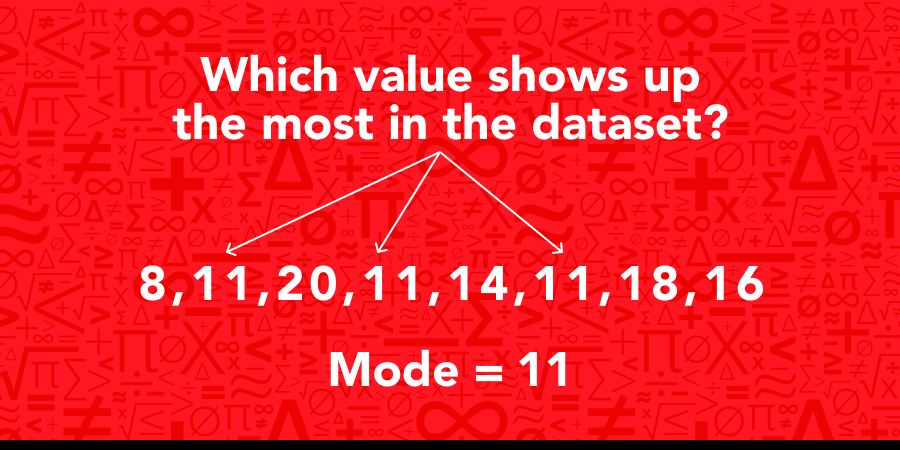Whether you're just starting to learn about the mode, getting ready for a standardized exam, or looking to get ahead in your statistics course, this guide is for you.
Read on to find simple definitions, easy-to-follow instructions, real-life examples, and practical exercises to help you understand and master the mode in math.
Find Top-Rated Statistics Tutors Near You
What Is Mode in Math?
The mode is the value that appears most often in a dataset.
For example, if you have the dataset consisting of numbers: 3, 7, 7, 2, and 5—which number shows up the most?
The number 7, right?
7 appears twice, more than any other number, which makes it the mode in your dataset.

Similar Concepts
- Mean: The mean is the average of a dataset. We find it by adding all the numbers together and then dividing by how many numbers there are.
- Median: The median is the middle value in a dataset when arranged from smallest to largest. If there’s an even number of values, the median is the average of the two middle numbers.
Although not a measure of central tendency, another concept you will encounter when learning about the median is the range.
The range shows how spread out the numbers are by finding the difference between the largest and smallest values.
How Do We Use the Mode in Everyday Life?
Just like other measures of central tendency, learning and mastering the mode doesn’t just help us get better grades in math, it helps us understand common patterns in real life.
Let’s explore a few real-life scenarios and fun ways to use mode.
If an ice cream shop’s records show that they sell 40 vanilla cones, 30 chocolate, and 20 strawberry in a day, vanilla is the most frequently bought flavor. Which flavor is the mode? Vanilla is the mode for ice cream sales. And what’s the takeaway? The shop owner knows which ice cream to stock up based on their customer’s preference.
In a clothing store, if most customers buy medium-size shirts (M) over small (S) or large (L) sizes, medium is the size that sells the most. The M size is the mode for shirt sizes. Now the store knows to keep the racks fully stocked with the size most customers are reaching for!
You can also have fun with mode!
For example, in a class of 30 students where 5 have blonde hair, 11 have black hair, and 14 have brown hair, brown is the hair color that appears the most among the children. So, the mode is brown.
How Do We Find the Mode?
Finding the mode is easy if you follow these simple steps:
- Organize Your Data: Put the values in order from smallest to largest. This makes it easy to see which one appears the most.
- Count the Frequency: Count how many times each value appears in your dataset.
- Identify the Most Frequent: The value that shows up the most is the mode.
Now that we know the steps, let’s work through an example together.
Find the mode for the following dataset: 10, 12, 15, 10, 18, 15, 20, 10, 25, 12, 30
1) Organize the values from smallest to largest: 10, 10, 10, 12, 12, 15, 15, 18, 20, 25, 30
2) Count the frequency of each value:
- 10 appears 3 times
- 12 appears 2 times
- 15 appears 2 times
- 18 appears 1 time
- 20 appears 1 time
- 25 appears 1 time
- 30 appears 1 time
3) Find the most frequent value:
The number 10 appears the most, showing up 3 times, so 10 is the mode.
And that's how you find the mode—simple and straightforward!
Solved Examples of the Mode
We’ll now look at a few more examples to see how to find the mode in different situations.
Example 1
Find the mode of the dataset:
32, 45, 67, 45, 89, 45, 92, 34, 89, 45, 67, 78, 45
1) Organize the values from smallest to largest:
32, 34, 45, 45, 45, 45, 45, 67, 67, 78, 89, 89, 92
2) Count the frequency:
- 32 appears 1 time
- 34 appears 1 time
- 45 appears 5 times
- 67 appears 2 times
- 78 appears 1 time
- 89 appears 2 times
- 92 appears 1 time
3) Identify the most frequent value:
45 appears the most (5 times), so the mode is 45.
Example 2
Find the mode of the dataset:
22, 35, 35, 45, 45, 22, 30, 30, 50, 45, 22, 35, 50
1) Organize the values from smallest to largest:
22, 22, 22, 30, 30, 35, 35, 35, 45, 45, 45, 50, 50
2) Count the frequency:
- 22 appears 3 times
- 30 appears 2 times
- 35 appears 3 times
- 45 appears 3 times
- 50 appears 2 times
3) Identify the most frequent values:
22, 35, and 45 each appear 3 times, which is more frequent than any other values. So, the dataset has a modeof 22, 35, and 45.
Example 3
Find the mode of the dataset:
22, 28, 28, 33, 33, 38, 38, 43, 43, 48, 48, 52, 52, 57, 57
1) Organize the values from smallest to largest:
22, 28, 28, 33, 33, 38, 38, 43, 43, 48, 48, 52, 52, 57, 57
2) Count the frequency:
- 22 appears 1 time
- 28 appears 2 times
- 33 appears 2 times
- 38 appears 2 times
- 43 appears 2 times
- 48 appears 2 times
- 52 appears 2 times
- 57 appears 2 times
3) Identify the most frequent values:
28, 33, 38, 43, 48, 52, and 57 each appear 2 times. This dataset has a mode of 28, 33, 38, 43, 48, 52, and 57.
Your Turn: Find the Mode
Now that you know how to find the mode, it’s time to put your skills to the test!
Exercise 1
Find the mode for the following dataset:
35, 18, 10, 30, 25, 22, 16, 25, 18, 24, 16, 25, 18, 5, 30, 22, 22, 15, 40
Exercise 2
Find the mode for the following dataset:
24, 30, 25, 42, 27, 30, 35, 20, 30, 33, 28, 25, 26, 32, 30
Exercise 3
Find the mode for the following dataset:
22, 25, 36, 30, 27, 34, 50, 18, 32, 25, 42, 34, 48, 21, 40
FAQs About the Mode in Math
Here are answers to some frequently asked questions students and parents have about the mode in math.
1) When do students learn about the mode in school?
Students generally learn about the mode in middle school, often around 6th grade. It’s part of understanding basic statistics, which also includes concepts like the mean, mode, and range.
What if none of the numbers repeat in a dataset?
If no value repeats in a dataset, then there is no mode. This means that every value appears the same number of times.
2) What if two values repeat the same number of times? Which one’s the mode?
If two values repeat the same number of times, the dataset has more than one mode. This means both values are considered modes because they appear most frequently.
3) Can the mode be a decimal?
Yes, the mode can be a decimal. The mode is simply the value that appears most frequently in a dataset, so if a decimal value repeats more often than any other value, it can be the mode.
4) Which is more useful for understanding the dataset: mode or mean?
The mode is often more useful for understanding a dataset when you want to see the most common value, especially in categorical data. The mean can be affected by extreme values, while the mode highlights the value that appears most frequently.
Master the Mode with Top-Rated Tutors Near You
Mathnasium is a math-only learning center for K-12 students of all skill levels, including middle schoolers.
Using a proprietary teaching approach, The Mathnasium Method™, in a supportive group environment, our specially trained math tutors provide face-to-face instruction to help students truly understand and enjoy math.
Explore our approach to middle school math tutoring:
Students begin their Mathnasium journey with a diagnostic assessment that allows us to understand their unique strengths and knowledge gaps. Guided by assessment-based insights, we create personalized learning plans that will put them on the best path towards math excellence.
Whether your student is looking to catch up, keep up, or get ahead in their math class, find a Mathnasium Learning Center near you, schedule an assessment, and enroll today!
Find a Math Tutor Near You
Psst! Check Your Answers
If you have completed the 3 examples in the exercise, check your answers here:
- Answer 1: 18, 22, 25
- Answer 2: 30
- Answer 3: 25, 34
How did you do?

























